This short blog is in response to a recent support ticket querying whether particular domains display significant differences in terms of the ratio of referring subnets to referring IP addresses. We were asked what a “normal” value of this ratio could be.
A statistical study was performed on the Majestic Million data. We found that typical values lay within the range 1.2 to 1.8, and in general were less than 2. Figure 1 shows a scatter plot of the number of referring IPs versus that of referring subnets. Note that the “Big 4”, namely, Google, Facebook, YouTube and Twitter (having global ranks of 1, 2, 3 and 4 respectively) are highlighted.
Figure 1: Scatterplot of Referring IPs versus Referring Subnets
Figure 2 plots the ratio of the referring subnets to the referring IP addresses for the Majestic Million data plotted as a function of the global rank. The data are dispersed about a mean value of 1.233 with a standard deviation (shown by the red dashed lines) of 0.173, and a high correlation of 0.873.
Figure 2: Ratio of Referring IPs to Referring Subnets as a function of Global Rank
The histogram of the ratios shown in figure 3 displays a very high skewness to the left, with the highest number of values occurring between 1.2 and 1.3. The cumulative distribution shown in figure 4 demonstrates that 99% of the ratio values lie within 1.8.
Figure 3: Histogram of Referring Subnets/ Referring IPs Ratio
Figure 4: Cumulative Distribution of Referring Subnet/ IP Ratio
The table below shows the top 45 domain names in the Majestic Million listed in descending order of the ratio. The first 10 are highlighted in yellow. For comparison purposes, the first four globally ranked domains are also displayed highlighted in green.
Unsurprisingly, the table shows that, outside of the top 4, many domains names in the table appear to be from hosting companies, suggesting that the ratio may vary to some extent within different industries.
Want the Majestic Million free of charge? Majestic SEO have offered the Majestic Million as CSV free to download since October 1st, 2012 – For more details see our blog post.
- Ranking of Top Data Scientists on Twitter using MajesticSEO’s Metrics - August 19, 2014
- Measuring Twitter Profile Quality - August 14, 2014
- PageRank, TrustFlow and the Search Universe - July 7, 2014







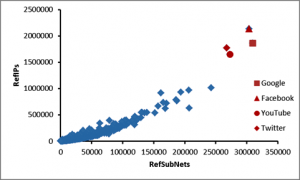
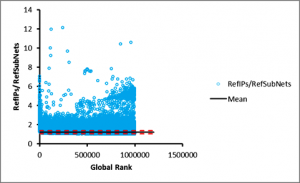
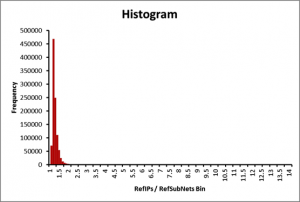
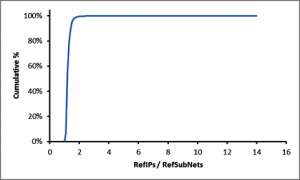
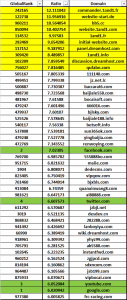
Class A:1.0.0.1 to 126.255.255.254
Supports 16 million hosts on each of 127 networks.
Class B:128.1.0.1 to 191.255.255.254
Supports 65,000 hosts on each of 16,000 networks.
Class C:192.0.1.1 to 223.255.254.254
Supports 254 hosts on each of 2 million networks.
Class D:224.0.0.0 to 239.255.255.255
Reserved for multicast groups.
Class E:240.0.0.0 to 254.255.255.254
June 25, 2013 at 4:20 pmReserved for future use, or Research and Development Purposes.
Hi Ryan,
Thanks for the summary.
Perhaps we should have been clearer that this article refers to the SEO definition of subnets, rather than the systems admin/networking definition, and thanks for giving me the opportunity to clarify this.
In a SEO sense, as with many metrics – the IPV4 “subnet” xxx.xxx.xxx.* definition is intended to be indicative, rather than formally correct. It’s often used as a metric by SEOs performing link counting to reduce the effect on the overall totals by distortions caused by small ISPs or farms of servers hosting many domains. We didn’t invent the term, but since more people became more SEO literate – and in particular aware of the dangers of high-volume, low-value link building campaigns we do get asked lots of questions along the lines of “Is my site normal” on support.
This post seemed to be a nice way of explaining a frequently requested statistic whilst supporting the series we are running on correlation.
June 25, 2013 at 6:51 pmHey Steve..
Does the ‘Global Rank’ of each domain in the table above has any SEO significance, in light of this article?…
Say, maybe some sort of different weight or importance placed on the specific IP subnets administered by each of those hosting companies (domains/networks)?
In other words, an IP listed under a better ranked domain from that table would ‘carry’ some more weight SEO-wise, too?
Cheers,
June 27, 2013 at 9:48 pm~Steve
I’ll try and respond to that… Though I might miss the mark…
I think if there’s a correlation it is unlikely to be causation. I think it is likely that the less domains per IP number, the higher the visibility of pages on Google – because Google’s crawler will try to avoid overloading a server and if it has 2000 websites on it, that will reduce site load speed and will also slow indexing times.
June 28, 2013 at 10:52 amSo to clarify, having a lot of IP subnets pointing at a site is not ideal (because these can be link networks) but if they are balanced with individual IPs it’s OK?
Cheers
July 1, 2013 at 11:31 am> Hi Paul,
Many thanks for the query. We aren’t trying to say what’s right or wrong here – we are just looking at a way of performing simple analysis to find out what is a “normal” IP/Subnet balance of referrers for a few domains. This research appears to show that the more popular sites on the internet tend to have well dispersed backlink relationships.
The techniques applied here could be applied to a given vertical – for example, you could use Majestic SEO to look at a number of competing sites in the same market, and then find the spread and mean IP/Subnet ratio.
If the vertical are have similar ratios, then it may be worth looking for insight in other data we provide, but if one of the sites has a significantly different ratio, it may give a simple to find “red flag” that may indicate dubious link building patterns, or some other potential are of improvement.
Of course – a quick look at the domains link profiles, and flow metrics will often give greater insight quicker – hence our investment in these metrics.
July 3, 2013 at 11:40 am